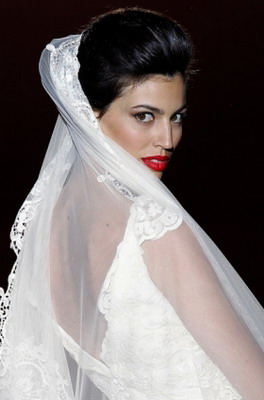For brides who have no previous experience with developing a wedding hairstyle or choosing a headpiece and veil (or deciding to go without), understanding how to attach and adorn the various components can be a challenge. In the twilight zone called wedding planning, the simple concept of a comb, for example, can take several forms.
In your everyday life, a comb is probably something to run through your hair in the morning taming nighttime tangles. Your hairdresser will certainly use that type of comb while creating your wedding hairstyle, but there are two other bridal versions you may need as well: a comb to attach the veil and one to decorate your hair. The choice is yours whether to have both versions, neither, or one to suffice for both uses.
When you buy a veil, it often comes attached to a basic comb. This veil comb is purely functional and will not be a visible part of your veil or hairstyle. It simply helps secure the veil to the top or back of your head. The advantage to using this type of comb with your veil is you can remove the veil after the ceremony while leaving your headpiece intact for the reception.









To place this type of comb, push it into your hair -- down if you are wearing your veil in back or toward the back of your head if you are wearing the veil on top -- so the hair covers the teeth and the veil hides the top of the comb. For a more solid base, insert with the comb angled then rotate backwards into place after the comb is in your hair. You can make the comb more secure, if needed, with bobby or hair pins.
These combs can be various widths and lengths and made of wire or plastic. Wire combs cost more than plastic, but are more versatile and can be pinned if necessary (as opposed to plastic, which is thicker and more cumbersome).
The Decorative Bridal Comb
Unlike the plain veil combs, decorative bridal combs are made to be seen. They can be a perfect accent for your veil, or add interest to your hairstyle if you go veil-less or remove the veil for the reception. The range of styles and sizes available make them versatile and can enhance most hairstyles, from classic to ornate. They can be simple, but elegant, depending on how they are decorated, but can also create a less formal look than some other headpieces.
Hair combs can be worn on the top, side, or back of the head. In the back, you can secure a large comb under a bunch of upswept curls, around a French twist, or beneath a low-set bun. On one or both sides, you can wear smaller combs for an elegant style, instead of a larger headpiece. Decorative combs can also be worn on the top to help hold the hair in place or function much as a tiara. In fact, you can even buy tiaras attached to combs instead of built into the typical band.
Tiara Combs
You have heard of tiaras and you have heard of combs, but you may not know that there are also tiara combs. These look like a tiara but hold your hair or veil in place like a comb. These decorative combs are made with the teeth positioned at an angle so the decorated part stands erect when attached to your hair from the front (as opposed to back or side combs, which are made with the decoration attached flat against or parallel to the teeth section).
Combining Veil and Decorative Combs
Some brides prefer to wear the veil and decorative comb as one piece. You can accomplish this by attaching the veil directly to a tiara or other top/back comb instead of to the plain veil comb. This reduces the number of pieces you must deal with when developing a hairstyle for the ceremony, but limits your options for the rest of the day. You will have to remove both your headpiece and veil or keep your veil intact throughout the evening.
Whichever type of combs you use, involve your hair stylist in the decision. He or she will most likely have valuable input into what sizes and types will most create the look you desire, while assuring your hair remains drop-dead gorgeous throughout the day and evening.